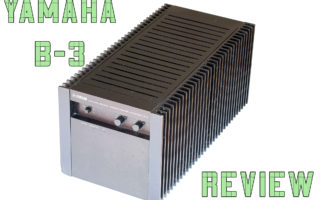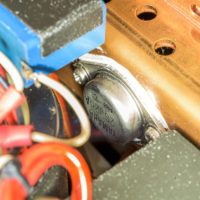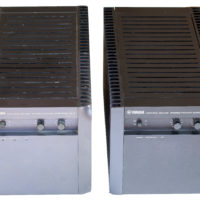There are certain points in life where you decide to get better car, better camera, better audio equipment or better wife. Today, it’s about audio equipment. About power amplifiers to be more specific. And to be exact, it’s about Yamaha B-3. She’s one of a few V-FET amplifiers out there, and on top of that, she can be bridged to a monoblock. I’ll explain what that means later.
I’ve heard and read nothing but praise for these amps, something like, best sounding solid state ever, there is nothing better than this, it’s a musical bliss, etc., etc. All this bollocks made me interested, so I’ve bought these amps from Japan. What’s so special about her you ask? Well, apart from the fact, she looks like a backup power supply or a small heater, it’s got V-FET transistors, you can pair the power amp with another one, she was limited only for Japanese market and she’s supposed to be some kind of holy grail of amplifiers. Let me first explain what power amplifier is.
People usually know what receiver or integrated amplifier is. What is power amplifier then and why would I use it, instead of more convenient integrated amplifier or receiver? Integrated amplifier is essentially a preamp with power amp integrated into one chassis. Like Yamaha CA-2000 of mine which I reviewed about a month ago. Preamp is the part that includes inputs, outputs, volume, some tonal adjustments like bass or treble and some minor amplification. Power amp only amplifies the signal, that’s basically it. And receiver is a preamp, power amp and tuner in one chassis. By making power amp a separate device with its own separate power supply, usually makes them far superior to integrated amps in terms of sound quality, because there was no compromise when they were building the amplifier. When creating an integrated amplifier, there usually needs to be some kind of compromise.
Yamaha B-3 is a standalone power amp, which is supposed to be connected to a preamp, but it’s not necessary to make it working. Without the preamp you’re stuck with just one input and power level knob. Which is perfectly fine for someone who needs to connect his DAC or any other single source that’s able to control the volume, if you need it. Sure, you can lower the volume with the pots on the amp, but I wouldn’t use it at all, because it kinda degrades the quality of the output and we don’t want to degrade sound quality of the holy grail, do we? You can’t, however, connect directly any device you want. For example your record player needs a phono pre-amp or the phono preamp needs to be integrated in the record player itself, otherwise it won’t work.
You have to be a bit careful if you’re connecting your source directly without a preamp. If you don’t use the level pots and your source is at maximum volume level, the amp is sending maximum power out and that could be pretty much fatal for your loud speakers, your ears or your poor cat sleeping on your speaker. You may be familiar with the saying: “there’s no preamp, like no preamp”. Though, it may be true for some preamp + power amp combinations, very good preamp may add some depth and quality. However, I want to know how this amp sounds without any additional interventions, so I’ve decided to test her with no preamp.
Unlike the CA-2000, which is Class A switchable to Class A/B, B-3 is purely Class A/B. Class A is considered being the best for audio reproduction, it uses maximum power all the time, even when the amp is producing zero output, which is better for distortion, but highly inefficient. The wasted energy is then converted to heat. Class A/B on the other hand is far more efficient with little to no sacrifice to distortion and thus sound quality.
History
As you’ve probably guessed, before B-3 there was B-2 and before that B-1. There were actually two more, BX-1 and B-2x, but they haven’t got V-FET transistors, so I’m not gonna include them here. B-1 was released in 1974, B-2 in 1976 and B-3 in 77, so they weren’t so much apart. B-3 is the last Yamaha’s attempt to conquer the market with something different, something special, but it lasted only for 4 years. It was a very short production, and after that, Yamaha switched to MOSFETs. But why? What was the reason? Were these amplifiers so terrible that Yamaha had to end the production? Well, let’s start from the beginning.
Right from the start, I am not sure who was the first, Yamaha or SONY, both of them came out with their first V-FET amplifier in 1974. SONY with their Integrated Amplifier TA-8650 and Yamaha with their B-1. Both of these delivered such an incredible sound, couple of other companies jumped on this bandwagon and released their own V-FET amps. JVC came out with JM-S7 power amp and JP-S7 pre-amp, Sansui with BA-1000 power amp, Hitachi and their Lo-d HA-500F and I heard somewhere, that maybe even Pioneer released one V-FET amplifier, but I couldn’t find any info about that.
Since all of the Yamaha’s V-FETs were power amplifiers, they needed little sisters, to make them complete. C-1 preamp was made for B-1 power amp. She was all-FET powered with V-FETs only in some stages and she’s considered to be one of the best preamps till this day. Unlike with the B-3, Yamaha nailed the design of both of these devices, they just look cracking. Then came out B-2 and along with it C-2, which already dropped the V-FET transistors and became considerably smaller. One year after the release of B-3, Yamaha didn’t release C-3, but rather C-2a for some reason. It looked almost the same as C-2, but it was much better. But apparently there was still room for some improvement and the ultimate C-2 version, called C-2x was released in 1985.
V-FET
V-FET (SIT) transistors were developed by this bloke Nishizawa Jun-ichi, known as Mr. Semiconductor, and rightly so, not only he was pretty good at his job, he was so obsessed with it, he was actually thinking about naming his son after a transistor. And as him being Japanese, there were only Japanese companies utilizing V-FETs in their products. Yamaha, Victor, known as JVC outside of Japan, Sansui, SONY, Hitachi and maybe Pioneer. Unlike Yamaha, JVC and Hitachi, SONY also produced Integrated Amplifiers with the V-FET transistors. I’d like to get my hands on all of those, one day.
It’s one of Yamaha’s milestones, as they present on their website: https://usa.yamaha.com/products/contents/audio_visual/hifi_components/hifi-history/separate-amplifier/index.html. As lots of other Japanese audio equipment, Japanese kept these just for the Japanese market. They had to keep the best bits for themselves. About 5000 units were made and they were sold for 200 000 yen, which is something like £2500 or $3500 in today’s currency. I wanted to get more info online, but it’s practically impossible to fine some, except for a brochure and very brief article on Yamaha’s web site. How typical.
Why did Yamaha end the production so early, then? There were probably more reasons to that. As usual, main reason was the money. V-FET transistors were much more expensive to manufacture than newly appeared MOSFETs and Yamaha just abandoned better for cheaper. It was very difficult to work with V-FETs, they needed very reliable power supply and could get very hot and that may have been another reason for ending the production.
Design
She is perhaps nothing you want at home. Or at least you don’t want to look at her. Why would a company that created piece of art like CA-2000, produce this? Maybe it’s for practical reasons? Maybe we’ll find out later, when I take her apart. There is nothing special about the front panel, there is a power switch, a power led indicator, BTL led indicator and two level knobs. That’s pretty much standard for any power amp, they don’t need anything else. What is not standard, however, to have the same level knobs on the back panel as well. I wasn’t sure what that was supposed to do, so I had to try it, obviously and both work the same, kind of. It behaves quite strangely. When I turned down either one or the other, it lowered volume by -20dB, so far so good. But when one of them was all the way down, so the volume was lowered, the other then increased the volume, even though the pot was turning to negative numbers. So, if you turn both to -20dB, you get maximum volume, makes sense.
Right next to the back panel level knobs is a coupling switch. In AC mode, it’s essentially high-pass filter. It filters very low frequencies and lets anything above 10Hz pass. It also sort of protects your audio equipment against unwanted parasitic power spikes. On the other hand, no filters are perfect and DC mode should sound slightly better.
One of the most important parts of this amp is BTL mode. BTL stands for “bridge-tied load”. It means, that the amplifier uses all its power only for one channel and thus you need two of these, one for right and one for left channel to get stereo. Like this, you’ll get twice the power which is 140W per channel, and I wonder if this kind of setup changes sound quality in any way compared to stereo. To get the amp working in the BTL mode, you need to connect one of the channels to BTL labelled RCA connector and flip the mode switch to BTL. And of course, you need to do the same with the other channel and the second amp. Speaker goes to the terminals labelled “BTL”.
Inside
Let’s have a look inside, maybe I can find the answer there, why it looks how it looks. The very heart of this amp are four V-FET transistors. If you look at where the transistors are, you notice that the entire chassis is basically one big heat sink and however ugly it may look, it makes quite effective cooler. It’s a cracking design, not very appealing, but very efficient. These are improved transistors used in B-2. What’s so special about V-FETs and how they differ from other types of amplifiers, then? Ever since the first transistors were used in an amplifier, there’s been a raging war between two sides. Those who love the sound of valve amps also known as tube amps in the US and those who love the sound of transistors. There are tons of different types of transistors and today most widely used amplifiers use MOSFET or BJT transistors, but valve amps are still considered to be a benchmark in the audio industry, but are they, really? Valves sound a bit different compared to transistors, some people prefer one over the other. Even though V-FET transistors are pretty much gone today, they used to be part of high-end audio family and they are said to be as close to valves as transistor will come. I’ve never heard a V-FET amplifier before, but that statement says a lot, if true. So, I just went and bought a pair of these to make sure I’m not missing on anything.
V-FET stands for Vertical Field Effect Transistor also called SIT, which stands for Static Induction Transistor, it’s the same thing, but I fancy calling it V-FET it’s more common. V-FET transistors’ characteristics are better compared to other transistors, like lower noise, distortion or higher audio frequency power. The sound coming out of these amps should have some unique qualities. However, they’ve got two serious problems. They can get too hot and they were very expensive to produce. They required reliable bias supply, otherwise they just didn’t survive. Some Sony V-FET amplifiers are known for being rubbish, they always blew up, unless you replaced some of the components immediately after the purchase. Yamaha did much better job.
As well as transistors, some capacitors were developed specifically for this model. And since it’s no longer in production, if either of these goes tits up, the amp is pretty much useless. They could, theoretically, be replaced by something newer and similar, but it wouldn’t sound the same. Despite it being called power amplifier, she wasn’t considered to be powerful at the time of the release. It was the time when more power equalled better and B-3 wasn’t particularly powerful, at least in stereo mode. Power output is either 70 watts per channel at 8 ohm in stereo mode or 140 watts in mono mode. But it’s still plenty powerful for my needs.
About a month later…
I was a bit sceptical and didn’t expect much. But to be honest, it really is brilliant. In my last amplifier review, which was Yamaha CA-2000, I was quite impressed by the sound. However, the sound coming out these amps is simply unbelievable. It’s on an entirely different level. I’ve been using it for everything, music, movies, games, etc., and it delivers in every department. For those who love live music, this amp brings it almost literally to your home. She just fills the room with the presence of the performer and the instruments, it’s almost perfect.
Is it worth having two of these in BTL mode, then? To make it short, it’s definitely worth it. The difference is subtle, but you can clearly hear the finer details, and the individual instruments in songs are a little bit more separated and more pronounced. I’ve also noticed it’s got a deeper bass. I wanna keep these, because it really is a wonderful piece of electronics. And since the V-FET transistors are no longer produced, I’ve even bought a third amp as a backup if one of those I’ve got goes up in flames. As I’ve read through all sorts of discussions on the net, people usually can’t decide which one of those three Yamaha amps is better. I’ll try to get B-1 and B-2 and pit them against these two mingers. And of course, I’d love to compare them to Hypex and other V-FETs as well. Until then, I’ll be using these every day. I don’t know how to put it, but I kinda became addicted to her. Or maybe it’s more appropriate to say to the sound. I just want to listen to anything that comes out of her all the time. And that’s exactly what I’m gonna do right now, see you lot next time.







